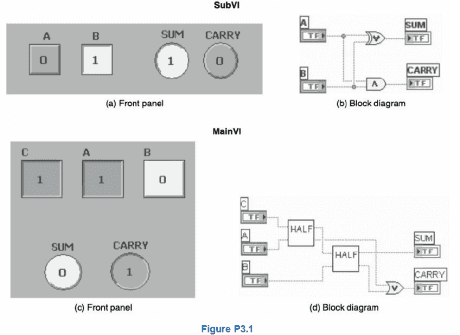- Dataflow Programming and Data Types in LabVIEW
- LabVIEW Interview Questions
- LabVIEW Programming
- LabVIEW Tutorial
- Block Diagram in LabVIEW
- LabVIEW Graphs and Charts
- Initializing Arrays In Labview
- Introduction of Repetition And Loops in LabVIEW
- Local and Global Variables in LabVIEW Tutorial
- Overview Of Clusters In Labview
- Shift Registers in LabVIEW
- Labview Structures
- LabVIEW Projects and Use Cases
- How to install LabVIEW on Windows
1. Create a VI to compute full adder logic using half adder logic as subVI.
Solution: The front panel and the block diagrams for the half adder is shown in Figures P3.1(a) and P3.1(b). Create a subVI called “HALF” and use this in the main VI to create a full adder as given in Figures P3.1(c) and P3.1(d).
If you would like to Enrich your career with an Android certified professional, then visit Mindmajix - A Global online training platform: “LabVIEW training” Course.This course will help you to achieve excellence in this domain.

2.Create a VI to find the decimal equivalent of a binary number using subVI.
Solution: To find the decimal equivalent of a binary number, first create the front panel and the block diagram as given in Figures P3.2(a) and P3.2(b). Then create the subVI called “Binary to decimal” and use it in the main VI as shown in Figures P3.2(c) and P3.2(d).
![]()
3.Create a VI to find the Grey code equivalent of a BCD number using subVIs.
Solution: Create the front panel and the block diagram as given in Figure P3.3(a) and P3.3(b). Then create the subVI called “BCD to GRAY” and use it in the main VI as shown in Figure P3.3(c) and P3.3(d).![]()
4.Create a VI to find the roots of a quadratic equation using subVIs. Find both the values of the roots and the nature of the roots.
Solution: Create the front panel and the block diagram as shown in Figures P3.4(a) and P3.4(b). Then create the subVI and use it in the main VI as shown in Figures P3.4(c) and P3.4(d).
Frequently Asked LabVIEW Interview Questions & Answers

5.Create a VI to find the average of two numbers and convert a section of a VI into a subVI.
Solution: The block diagram to find the average of two numbers and convert a section of a VI into a subVI by selecting that portion is shown in Figures P3.5(a) and P3.5(b) respectively.![]()
6.Create the front panel and block diagram of the Main VI to show the trigonometric values (sine, cosine and tangent) of the given degree. This VI uses a subVI for finding the trigonometric values. The SubVI consists of functions for converting degree values to radians and functions to find the sine, cosine and tangent values separately. In LabVIEW the sine, cosine and tangent functions take input in radians.
Solution: Create the front panel and the block diagram as shown in Figures (a) and (b).
 On-Job Support Service
On-Job Support Service
Online Work Support for your on-job roles.

Our work-support plans provide precise options as per your project tasks. Whether you are a newbie or an experienced professional seeking assistance in completing project tasks, we are here with the following plans to meet your custom needs:
- Pay Per Hour
- Pay Per Week
- Monthly
| Name | Dates | |
|---|---|---|
| LabVIEW Training | Dec 27 to Jan 11 | View Details |
| LabVIEW Training | Dec 30 to Jan 14 | View Details |
| LabVIEW Training | Jan 03 to Jan 18 | View Details |
| LabVIEW Training | Jan 06 to Jan 21 | View Details |

I am Ruchitha, working as a content writer for MindMajix technologies. My writings focus on the latest technical software, tutorials, and innovations. I am also into research about AI and Neuromarketing. I am a media post-graduate from BCU – Birmingham, UK. Before, my writings focused on business articles on digital marketing and social media. You can connect with me on LinkedIn.
















